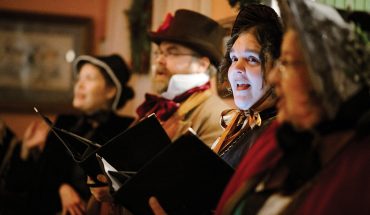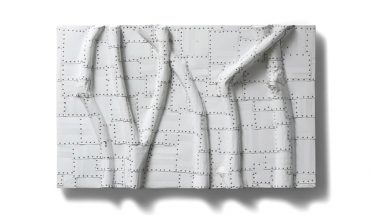
African-American Raleigh designer Willie Otey Kay created custom gowns for women all over North Carolina for more than 60 years. Many of her dresses are currently on exhibit at the North Carolina Museum of History.
by Mimi Montgomery
photographs by Catherine Nguyen
Custom, one-of-a-kind dresses are typically associated with haute couture – the glamorous reserve of New York and Paris fashion shows.
That wasn’t always the case. There was a time when custom-made gowns weren’t just found in the pages of Vogue or in high-end bridal shops, but in the closets of everyday people, created by local artisans who made everything by hand.
Willie Otey Kay, an African-American Raleigh designer and seamstress who created dresses for more than 60 years for women all over the state, was one such artisan. Along with her sisters, Kay made debutante and wedding dresses and evening gowns from the late 1920s until the 1980s. Her talents spread by word-of-mouth until her clients contained a who’s-who of North Carolina society and beyond.

The exhibit at the North Carolina Museum of History highlights Willie Otey Kay’s exquisite and extensive work.
Kay’s legacy lives on in Raleigh with an exhibition of her skilled craftsmanship at the North Carolina Museum of History. Some of Kay’s dresses had been in the museum’s archives for years, but this is the first time the museum has created a show devoted to Kay alone. “It seemed like an ideal exhibit opportunity to show off some of our collection, to tell her amazing story, and to really get the community involved too, since so many people … remember her and have dresses made by her,” says curator Diana Bell-Kite.
The community has certainly gotten involved: The exhibit opened January 16, but the response to loan dresses made by Kay was so great, the museum has had to add four rotating exhibits in an extra room to showcase all of the the borrowed creations. “It was really incredible,” says Bell-Kite. “We were just overwhelmed with people’s interest.”
What she did best
With a story as long – and creations as beloved – as Kay’s, it’s no wonder folks are interested.
Born in Raleigh in 1894, Kay grew up one of eight children on downtown’s Cabarrus Street. Her father Henry Otey was a prosperous African-American businessman who owned a barbershop inside the Yarborough House hotel on Fayetteville Street. He sent Kay to Shaw University, where she met and married medical student John Kay, and graduated in 1912 with a degree in home economics. The couple then moved to Wilmington, where Dr. Kay co-founded a hospital for African-Americans.
When her husband passed away in 1927, Kay returned to Raleigh. Back in her parents’ home on Cabarrus Street, Kay, now widowed with five children (two had passed away), looked to her innate talents to support her family doing what she did best – sewing.
Her work quickly took off. With the help of her sisters, Mildred Otey Taylor and Chloe Otey Jervay Laws, both talented seamstresses, and Elizabeth Otey Constant, who created beautiful and intricate beadwork, Willie Otey Kay provided some of the most coveted dresses of the era.
Indeed, Kay’s family was a talented one, and they played an important part in her life and her business, two aspects which were constantly intertwined. Kay’s great niece, Elizabeth Constant Lewis, recalls travelling with Kay and Elizabeth Otey Constant (Lewis’ grandmother) and the Otey sisters to deliver dresses to houses on Glenwood Avenue, then largely undeveloped. She remembers sitting down with her great-aunts to learn to make fabric roses by hand and taking breaks for beautiful lunches at her Great-Aunt Willie’s, served on her finest china.
“Sewing was just part of my life,” Lewis says today. “I feel like that’s something in the genes.” She still sews and beads, carrying on a family tradition that she says is simply innate: “not taught, just digested.”
Mildred Campbell Christmas, Kay’s granddaughter, agrees that the family’s creativity and skill were inherent. Kay made Christmas’ wedding gown (which incorporated lace from the dress she’d worn for her debut, which itself was made by Mildred Otey Taylor), as well as dresses for all of her bridesmaids. “She did it with such ease,” Christmas says. “She never seemed to be stressed or pressed.” A mere glance at a designer dress hanging in a store was all Kay needed to sketch and create an identical dress for a fraction of the price, Christmas says, which had some Raleigh department going so far as to try to keep Kay from coming in to shop.
Kay eventually moved into her own house on New Bern Avenue, where she had a sewing room off her living room. Clients would come to the house for their fittings. Kay kept a stack of magazines that brides and debutantes could flip through for inspiration, and once they had an idea of their ideal gown’s design, she would sketch it for them. Many customers recall only having one fitting, and Kay didn’t work with pre-made patterns – it was all expertise and intuition.
News of her skill with a needle and cloth quickly spread beyond Raleigh: When Dr. Synthia Teele Roberson was planning her 1961 debutante ball in Tallahassee, Fla., her aunt, who was also Kay’s neighbor, told her she had no choice but to make the trip to Raleigh to have her dress made by Kay. Roberson liked it so much she came back in 1969 to have Kay make her wedding gown and bridesmaids dresses. Roberson only had one fitting for her wedding gown, and her bridesmaids never even stepped foot in Kay’s sewing room. But “they were perfect,” Roberson says. “We didn’t have to do any adjustments.”
Made for you
Kay’s easygoing demeanor and professionalism extended beyond the borders of her at-home sewing studio, those who recall her say. The middle of the 20th century was a difficult period for African-American-run businesses in the South. But during a time of segregation and racial tension in Raleigh, Kay worked with both African-American and white clients, making an equal number of dresses for the predominately African-American Alpha Kappa Alpha debutante ball and the predominantly white North Carolina Debutante Ball.
Each season, girls would vie for a coveted appointment at Kay’s house, where she was sure to keep all her dresses tucked away in a cedar closet so no one knew what another’s dress looked like. After their debut, many girls kept their dresses to use when they later got married. Kay would advise them on how much extra fabric to purchase and save for a train, and dresses were often passed down from mother to daughter, aunt to niece, each with the special sewn-in tag “Made especially for you by Willie Kay.”

Louise Talley stands with a custom gown made for her North Carolina Debutante weekend on loan for the exhibit.
Louise Wooten Talley remembers girls coveting those dresses with Kay’s tags when she left her hometown of Goldsboro to attend St. Mary’s School in the 1950s. When she was invited to participate in the 1954 North Carolina Debutante Ball, Talley went shopping for dresses, and “not only were they expensive, I didn’t think any of them were as pretty as Willie Kay’s,” she says.
Luckily for her, she was able to schedule a meeting with Kay, who made both her debutante gown and the evening gown she wore to the second-night party after the ball. Talley provided her own sketch for the evening gown to Kay, who created the lace bertha collar Talley wanted, and even dyed the fabric green to match.
“She was very good with young girls,” Talley says. Her daughters even went back to Kay for alterations when they wore Talley’s original debutante gown for their own debuts. “She knew just what to say to make a young girl feel special … She was like everybody’s ideal grandmother.”
Kay sewed well into great-grandmotherhood and her 90s, making gowns as well as christening outfits; beaded handkerchiefs; a glove bag for the Links organization (of which she was a member); and the vestments for her church, St. Ambrose Episcopal. She was featured in McCall’s magazine in 1935, and one of her debutante gowns was on a 1951 cover of Life magazine.
Most importantly, her living relatives say, Kay was able to send all five of her children to college with the proceeds from her work. They, in turn, left their own imprints on history. Her youngest daughter, June Kay Campbell, was honored by the N.C. General Assembly for her role in the civil rights movement and went on to raise two sons who were both prominent politicians: Bill Campbell, mayor of Atlanta from 1994-2002, and Ralph Campbell, Jr., State Auditor from 1993-2004 and the first African-American to hold elected executive office in North Carolina.
A walk through the Willie Otey Kay exhibit is more than a fashion exhibition. It is a step through North Carolina and Raleigh history, spanning multiple decades, rippling out far beyond her sewing studio. It’s a story preserved in lace and silk, in time and stitches, in family and memories – each a fold of a greater fabric that will be passed hand-to-hand for generations to come.
Made Especially for You by Willie Kay runs through September 5; Additional dresses on display June 2 – 16 and August 22 – September 5; free; North Carolina Museum of History, 5 E. Edenton St.;
ncmuseumofhistory.org









